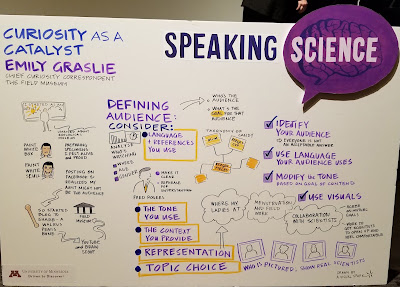 |
| Graphic recording by Amy Sparks of A Visual Spark (1/17/2019) |
Preparation prior to the interview is key. This allows the scientist to make sure they are communicating accurate information. In some situations, it is acceptable to politely refuse to answer questions if the news media misrepresents their stated intentions and questions are about topics that are not fully researched.
Tips from the notes above: Test out your ideas to regular folks prior to talking with the reporter, and be prepared to share what is important to you. Know the controversy well and address it directly. Let the audience know why they should care. Promptly contact the news director for factually incorrect information so a correction can be made to the web post.
Practice with a podcast or talking with others to get comfortable in front of the camera. A good news reporter will do what they can to put their interview subject at ease. If you are super shy, you can refer the reporter to another scientist who is more comfortable in front of a camera.
Timothy Blotz interviews Amazing Race winner Dr. Natalie Strand - 4 min.



